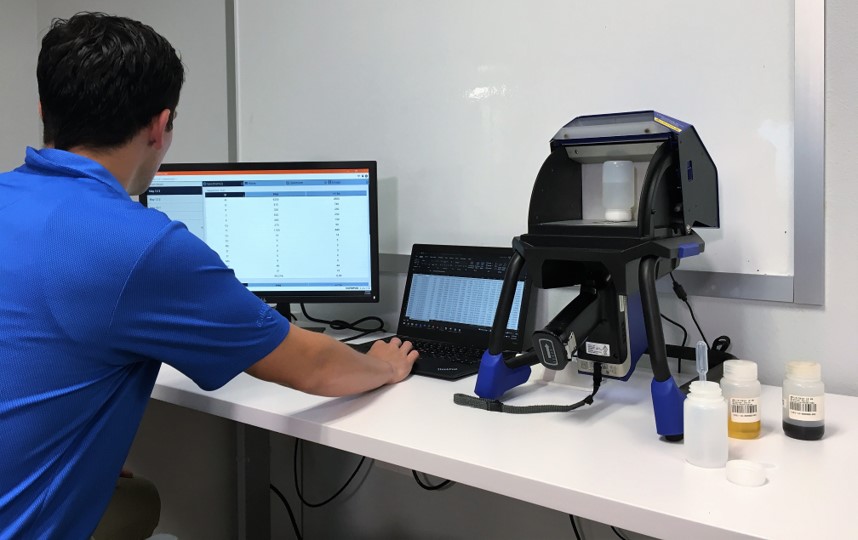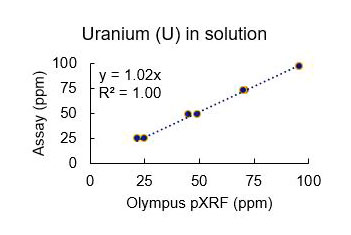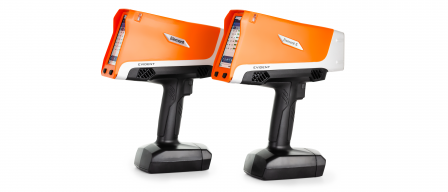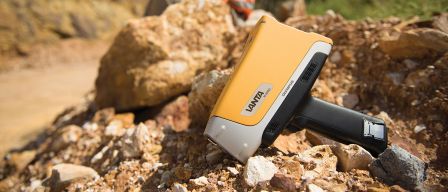
Portable XRF (pXRF) instruments, such as Olympus’ Vanta™ handheld XRF analyzer, can play a critical role in the exploration and mining of uranium ores and deposits by accurately measuring low parts per million (ppm) uranium concentrations in a wide variety of deposit types.
The Vanta pXRF analyzer provides excellent performance in various ore samples, including sandstone, breccias, iron ore copper gold (IOCG), and quartz monzonite—matrices that commonly contain uranium (U) ore. These U-containing deposits and matrix types can be found across the world. Various active mines, including the McArthur River mine, Olympic Dam, Cigar Lake, the Husab open-pit uranium mine, and the Westmoreland Project, all contain these deposit types.1 The graphs below demonstrate that the Vanta pXRF provides accurate, precise results across all matrices and concentration levels, as indicated by the slopes and R2 being close to 1.

Figure 1. Vanta pXRF performance of uranium and related elements for mining and exploration
One common type of uranium mining extraction is through in-situ leaching (ISL).2 This technique dissolves uranium ore-containing minerals, which are then pumped to the surface. Through ISL, uranium miners can extract uranium ore without using the more expensive traditional mining techniques. Almost 60% of the world’s uranium comes from ISL-mined uranium. Similar to traditional, solid bulk analysis of uranium ore, it is critical to mining efficiency to determine the concentration of uranium in the liquid solution. The Vanta pXRF can accurately determine this concentration in the field without extensive sample preparation.

Figure 2. Vanta pXRF performance of uranium in solutions during in-situ leaching
While detection of uranium down to low single digits is a requirement for geochemical analysis, many mines need even lower detection limits for common types of exploration. To find regions with these very low concentrations of uranium, pathfinders are commonly used. These pathfinders include elements common to the deposit of interest, such as:
- Nickel (Ni), arsenic (As), molybdenum (Mo), and lead (Pb) in unconformity deposits
- Sulfur (S), titanium (Ti), iron (Fe), selenium (Se), and Mo in sandstone deposits
- Fe, Copper (Cu), silver (Ag), barium (Ba), gold (Au), and rare-earth elements (REE) in IOCG deposits
| Element of Interest | Pathfinder Elements |
| Unconformity | Ni, As, Mo, Pb |
| Sandstone | S, Ti, Fe, Se, MO |
| IOCG | Fe, Cu, Ag, Ba, Au, REE |
| Quartz-pebble conglomerate | S, Ti, Fe, Ni, Ag, Au, REE |
Advantages of Using the Vanta™ pXRF Analyzer for Uranium Mining and Exploration
Olympus’ Vanta pXRF analyzers offer many analytical advantages and features for uranium mining and exploration,including:
- Inexpensive and minimal sample preparation
- No need for extra hardware or infrastructure, including external power, compressed gasses, or sample chambers and stages
- Rapid and high-throughput testing with fast elemental quantification
- On-site analysis and results in seconds to minimize downtime at the mine or worksite
Learn more about the Vanta handheld XRF analyzer on our website or reach out to your local sales representative to set up a demonstration.
References
- World Nuclear Association. (2020, September). Uranium Production Figures, 2010-2019. Retrieved March 08, 2021, from https://www.world-nuclear.org/information-library/facts-and-figures/uranium-production-figures.aspx
- Vance, R. (2014). Uranium 2014: resources, production and demand. NEA News, 32(1/2), 26.




